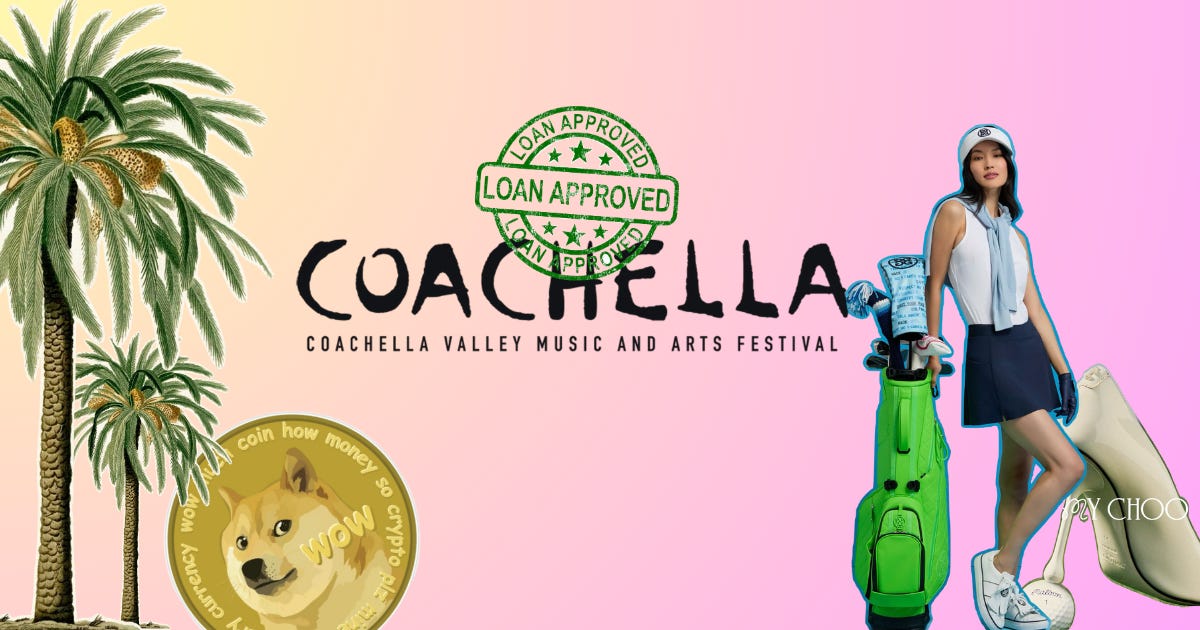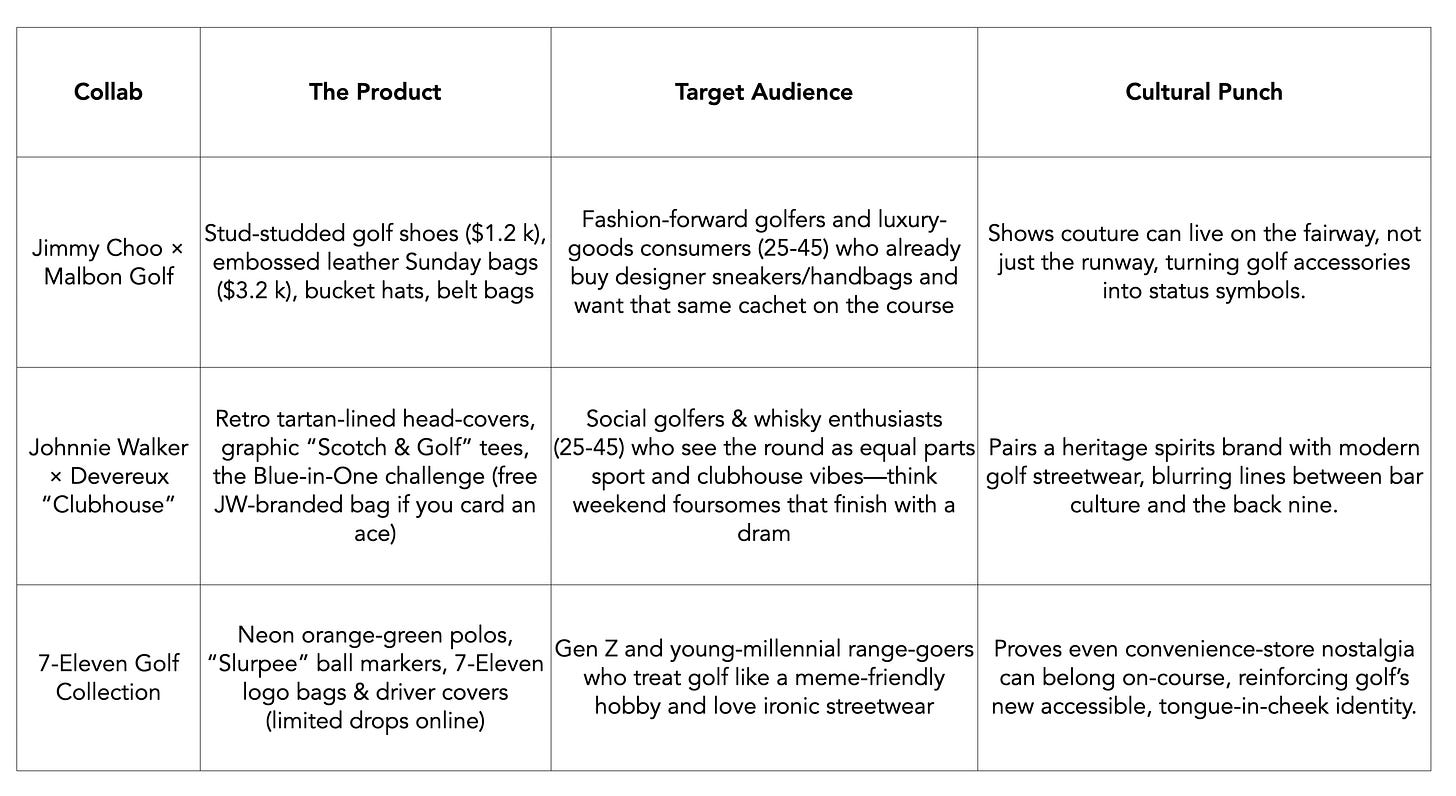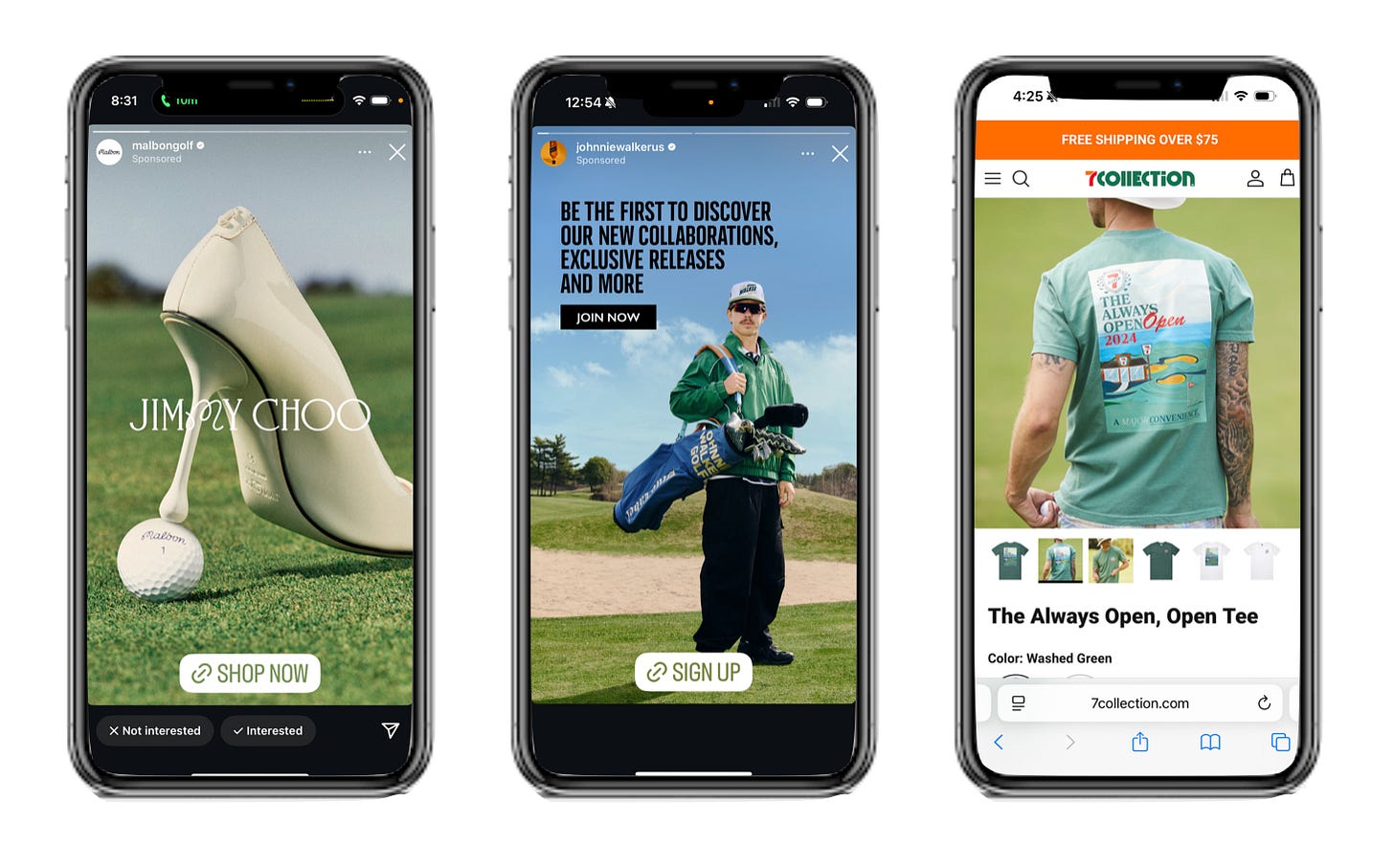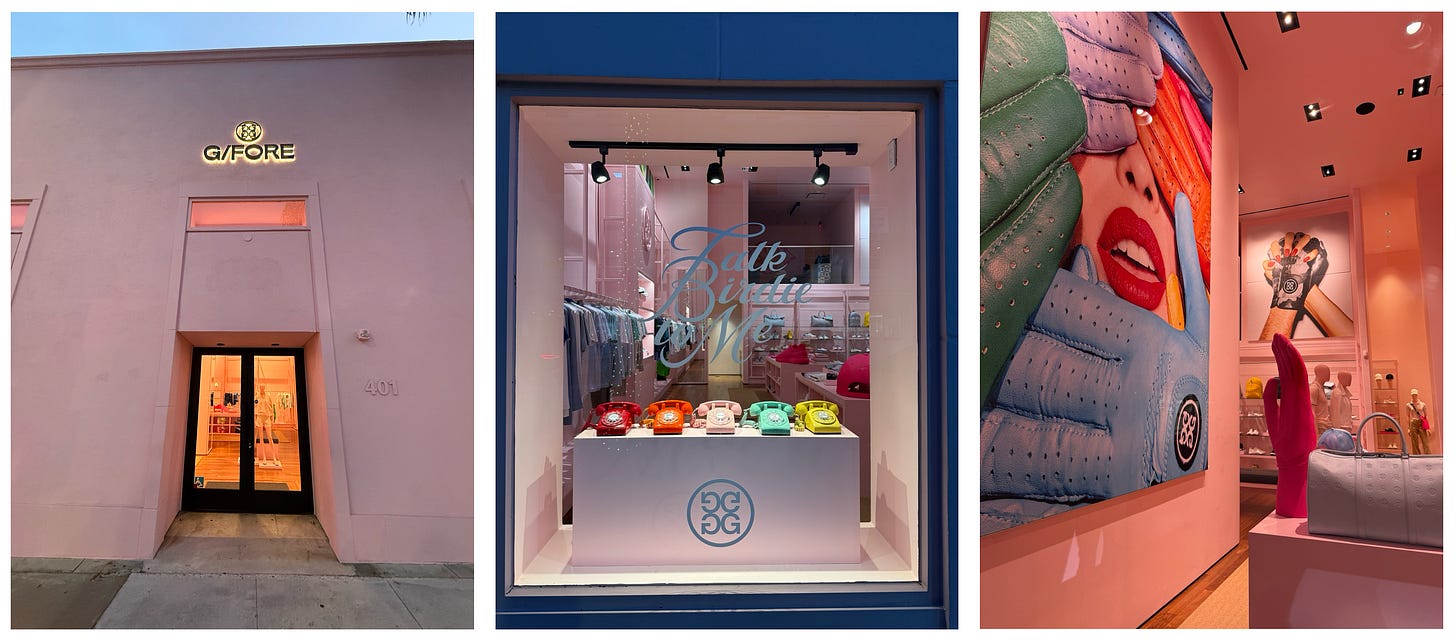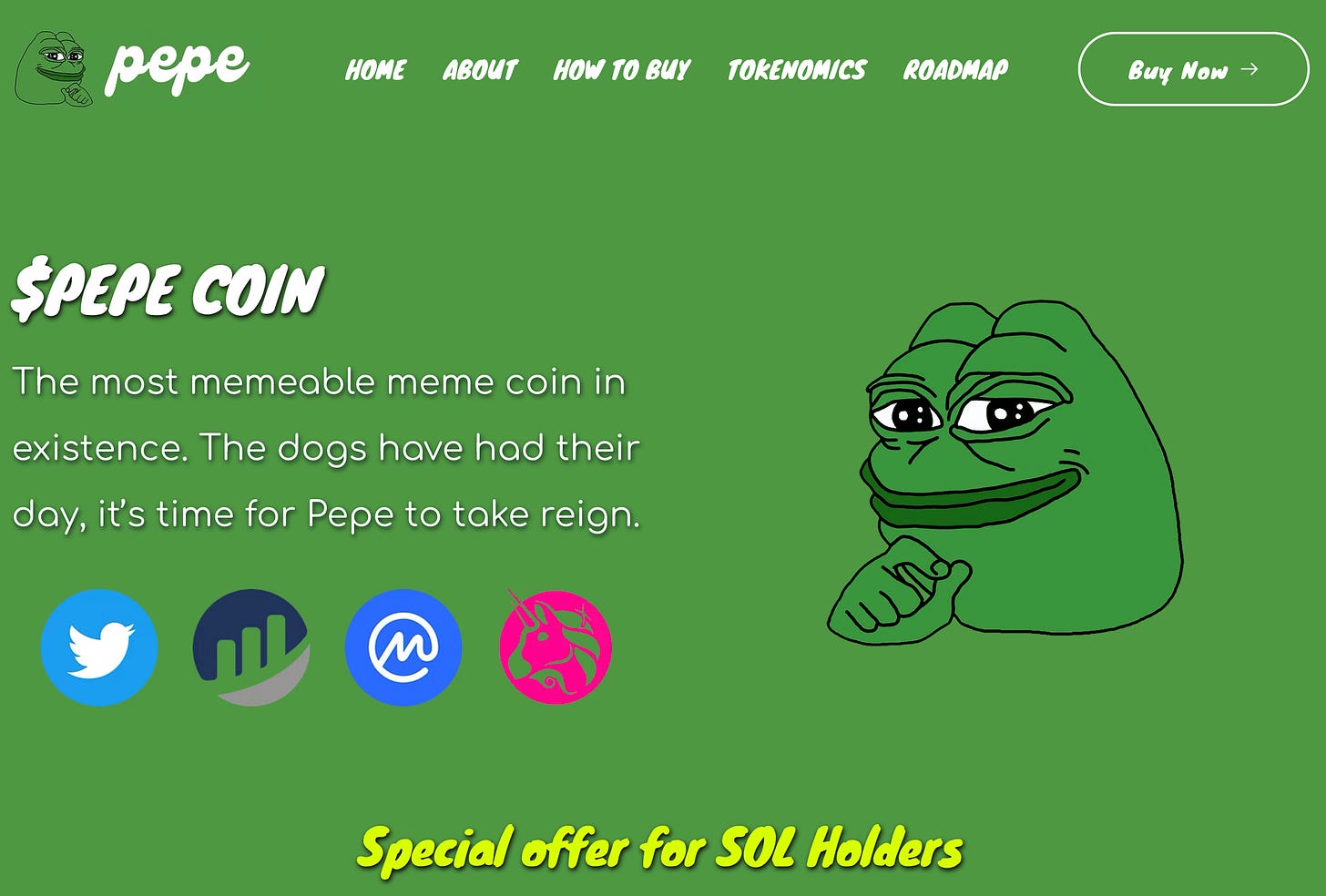Golf Drip, Memecoin Marketing & Festival Debt
Couture clubhouses to crypto TikToks and desert raves on loan
Issue #8
Hello! Welcome to this week’s Culture Curve. 🙋🏻♀️
Today, we’re teeing up:
Golf’s sudden style renaissance + my reflections from growing up on the links.
The marketing magic (and madness) fueling memecoin trends in crypto.
Why some fans are literally borrowing money to dance in the desert at Coachella.
A New Era in a Traditional Sport
You’ve probably noticed it: golf is hot right now. The sport that was once reserved for retirees, corporates and professionals has turned into a global phenomenon—complete with streetwear collabs, sexy marketing campaigns, and a level of hype that feels closer to sneaker culture than corporate culture.
The boom in golf between 2020 and 2025 has been wild. Global golf participation grew from 61 million in 2020 to nearly 70 million by 2025, marking the highest number of golfers in history.
I’ve had a front-row seat to it—not just because I grew up playing competitive golf in India—but also because my sister and brother-in-law are professionals (yes, it’s their actual jobs) and my Dad plays four times a week (minimum). My mom’s favorite punchline is that everyone in our family is either a professional golfer or likes to behave like one. 😶🌫️
In my early junior golf days, my apparel options were pretty limited: I’d grab a subdued, unoffensive and ill-fitting polo from Lacoste or Adidas, throw on Forever21 khaki shorts or trousers (golf etiquette doesn’t allow denim) and step into a pair of dependable—but hardly fashion-forward—FootJoy golf shoes. The dress codes were strict, the culture felt exclusive, and options for self-expression were minimal at best.
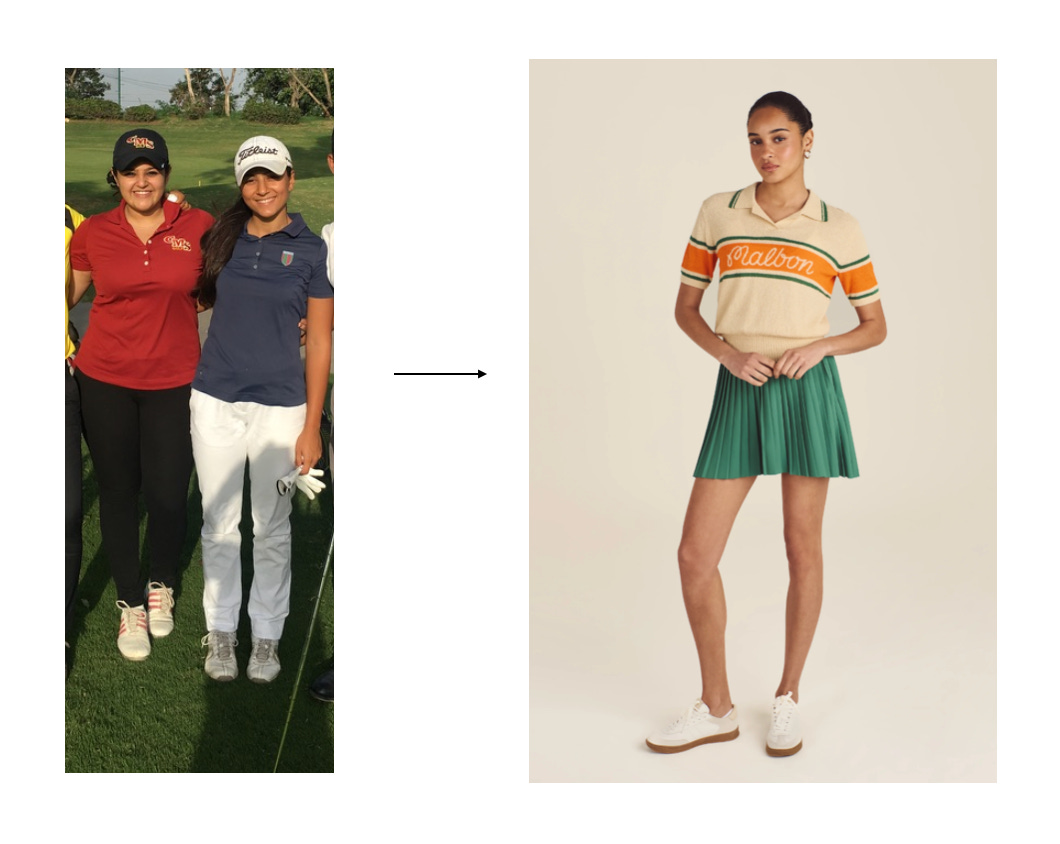
Today, it’s a whole new ball game. Netflix’s Full Swing, TikTok #GolfTok, and a pandemic that forced us outdoors lit the fuse. Young players under 35 make up 35% of new golfers (per the 2025 National Golf Foundation Report), fueled by social media hype and charismatic pros.
Now the fairway looks like a runway. It’s thrilling to watch a once-buttoned-up sport embrace such creativity and inclusivity… but where do we draw the line?
From Function to Fashion
Historically, brands like Titleist, Callaway, and Ping led the market with functional gear, while FootJoy and Nike Golf catered to apparel and footwear. Their designs were classic, reliable, and rarely ventured beyond safe color palettes. Now, we’re riding a streetwear-meets-golf wave: labels like Malbon Golf are bridging the gap between athletic performance and style-savvy expression, bringing fresher silhouettes and bolder prints to pro shops.
Here’s a bird’s eye view of the hottest golf collabs of 2025 and the varied audiences they cater to:
I also recently chanced upon a new brand called G/Fore that has just opened a boutique in Beverly Hills right next to my favorite cafe. I can’t speak for the products, but the branding has hyper-sexualized golf in the most on-the-nose manner possible and felt like an IRL version of a click-bait ad for me:
A $10B Question
The current boom in golf fashion is a testament to how fast consumer preferences can shift. The global golf apparel market is on track to cross $10 billion by the end of 2025, reflecting just how big the opportunity is. Whether you’re a long-time fan or new to the scene, we’re witnessing a cultural renaissance in a very traditional sport.
As someone who loves the game, has seen its evolution firsthand and has worked in the hype world of sneakers and fashion collabs at Nike, I hope the younger brands entering the fray can respect the ethos of golf while still having fun with it.
As much as I hate to, I’'ll have to accept that there will inevitably be the G/Fores of the world: well-funded brands looking to ride the hype train and grab eyeballs without a thought about diluting the sport’s values.
The question remains: how pervasive will these hype collabs truly become in what’s historically been considered a “gentleman’s game”?
Memecoin Marketing Trends in Crypto
Memecoins—cryptocurrencies that hinge on memes, humor, and viral culture—are a sub-sector of the crypto world that first gained prominence with the explosive rise of Dogecoin back in 2021 (remember that?). Since then, memecoins have ballooned to a combined market cap of around $80 billion in 2025, according to CoinMarketCap. I’ve always wondered: what’s marketing’s role in memecoins and is it a replicable formula?
Let’s break down the three key strategies these coins use to go viral and if it’s truly a formula that can be replicated.
Celebrity & Athlete Endorsements
Celebrity endorsements exploit the follower bases of influential figures. While this can create a rapid influx of buyers, regulatory scrutiny is intensifying. Undisclosed promotions or “pump-and-dump” schemes can result in hefty fines or reputational damage.
Elon Musk & Dogecoin: The Tesla CEO’s tweets continue to boost DOGE’s visibility, even five years after his initial endorsements. In 2025, a single cryptic tweet referencing the Doge logo sent DOGE’s market cap soaring by $2 billion within hours.
Viral Social Campaigns
These campaigns often revolve around quick, snackable content—short videos, memes, or polls that are easy to share. The reliance on social platforms creates a powerful feedback loop: every retweet or TikTok stitch magnifies the coin’s visibility, pulling in new speculators.
Pepe (PEPE): In early 2025, a viral TikTok challenge using Pepe memes catapulted PEPE’s price by 120% in just 48 hours. Influencers and everyday users posted comedic sketches referencing the cartoon frog, turning the token into a digital sensation.
Meme-First Branding
Goofy or surprising names and references spark curiosity, attracting social media users who want to be part of the joke. The communal sense of “we get it” fosters a tribal loyalty that can make or break a memecoin’s success. The storyline itself (e.g., “Our coin is the next big thing—just trust the meme!”) is often enough to lure new buyers.
Shiba Inu (SHIB): Positioned itself as the “Dogecoin Killer,” with a brand aesthetic that leans heavily on the cute-but-feisty Shiba Inu dog meme. Its website and marketing copy revolve around ironically grandiose promises of dethroning established coins, which ironically helped build a hardcore community.
Is the Formula Replaceable?
At its core, the memecoin marketing formula—meme-laden branding, viral social pushes, and celebrity co-signs—is replicable. Dozens of new tokens try to copy this template every month, hoping to recreate the explosive gains seen by Dogecoin or Shiba Inu. However, the success of these coins often depends on timing, luck, and the intangible “community factor.”
Timing & Market Sentiment: A newly minted token can soar if it lands during a crypto bull market, when investors are more prone to speculative bets.
Community Factor: Memecoins with devoted online communities that genuinely enjoy the humor and camaraderie fare better. It’s tough to replicate true grassroots energy without authentic meme appeal.
Virality vs. Longevity: Even if a coin goes viral, sustaining that hype is tricky. Many memecoins fade once the jokes get old or the market cools.
Why Are Memecoins So Viral?
FOMO & Gamification: The rapid price swings make memecoins feel like a game—people jump in to avoid missing out on “the next big thing.”
Low Buy-In: Memecoins are often priced at fractions of a cent, giving new investors the perception they can own millions of tokens cheaply.
Humor & Shared Culture: Memes transcend language barriers and build instant connection. People want to be part of something fun and unique, which can fuel unstoppable momentum—at least in the short term.
Memecoins embody “marketing meets speculation.” While the tactics are the same, only a few become mainstream hits. Research, caution, and a healthy dose of skepticism remain crucial for anyone diving into this whimsical corner of crypto.
Taking Loans for Coachella: A Surprising Trend
The Price of Festival FOMO
Coachella 2025 tickets started at $799 (general admission), climbing to over $1,200 for VIP. Factor in flights, lodging, and your festival wardrobe, and a single weekend can easily exceed $2,000.
Financing the Fun
This year, over 60% of Coachella attendees bought their tickets using Buy Now, Pay Later (BNPL) services like Klarna and Affirm. Social media, rife with influencer outfit reels and brand-sponsored parties, fuels a FOMO so intense that some decide debt is worth it to be there.
In a world increasingly driven by experiences, going into debt for a festival calls into question how we weigh memories against financial stability. Is the “once-in-a-lifetime” rush of Coachella worth the burden of monthly loan repayments? For many, the answer lies in the tension between fulfilling a dream and facing the reality of debt—an inner conflict that speaks to a broader shift in our culture’s priorities.
Coming Up Next on Culture Curve…
🤖 Is the future of social AI influencers?
💄Why Hailey Bieber’s beauty brand was acquired for $1B within 3 years of hitting the market
🏨 Airbnb’s struggles to remain relevant
Stay curious, stay cultured, friends.
- Kasvi




